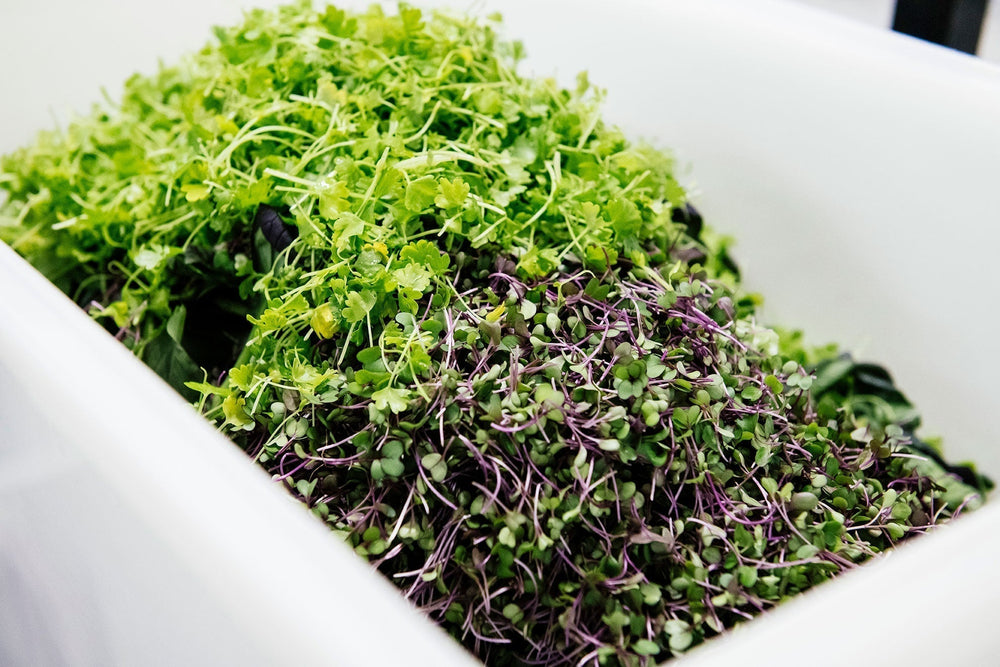
At Planted Detroit, we always see how something so small, like a microgreen, can make a significant impact on health and flavor. Tiny, delicate, and vibrant, microgreens are the kind of food that surprises you. They pack way more nutrition than you’d expect, and they’re fun to eat too; you don’t hear those two in a sentence often.
If you’ve ever wondered why chefs, health experts, and even busy parents are sprinkling these little greens on everything from smoothies to grain bowls, you’re in the right place.
In this blog, we’ll be learning about what microgreens are, their science-backed benefits, why chefs rely on them, fun kid-friendly ways to enjoy them, and some quick recipes you can actually make at home. Think of this as your all-in-one guide to bringing more green goodness into everyday life.
What Exactly Are Microgreens?
So, let’s start from the top; what are microgreens, really?
Microgreens are the young seedlings of vegetables and herbs, harvested just 7 to 21 days after germination. They’re different from sprouts, which are eaten right after they sprout, like alfalfa sprouts. Sprouts grow without soil and are eaten roots and all, while microgreens grow in soil or growing mediums and are clipped above the root, kind of like mini versions of fully grown greens.
They’re also not the same as baby greens, which are larger and harvested later. Microgreens fall right in between. They’re more developed than sprouts, but still packed with youthful intensity that you don’t receive from mature plants.
Some common varieties include radish, broccoli, sunflower, and arugula microgreens. Each variety has its own personality: spicy, nutty, fresh, or earthy. Add in their vibrant colors, delicate textures, and fragrant aromas, and you’ll see why chefs and home cooks love them not only for nutrition, but also for presentation.
When you think about it, microgreens are proof that good things do come in small packages.
The Science-Backed Microgreens Benefits

Let’s get into the interesting part now. Microgreens are not only pretty to look at and have a great texture, but most importantly, they’re nutritional powerhouses.
-
Studies show microgreens can pack up to 40x more vitamins and antioxidants than their full-grown versions.
-
Consuming a handful of broccoli microgreens can give you as much Vitamin C or Vitamin E as an entire plate of mature broccoli.
-
They’re loaded with vitamins A, C, E, and K, plus essential minerals like potassium, magnesium, and iron.
-
Sulforaphane is that superstar compound in broccoli linked to detoxification, heart health, and anti-inflammatory support, and it’s found in concentrated amounts in broccoli microgreens.
All of this adds up to the benefits of microgreens that you can actually feel in your body. You will experience better immunity, smoother digestion, sharper focus, and sustained energy throughout the day.
Detox and Daily Vitality with Microgreens
Let’s talk about the body reset we all crave from time to time. Microgreens are excellent allies for detox and daily vitality.
Packed with phytonutrients and antioxidants, they help your liver’s natural detox pathways work more efficiently. These compounds sweep away toxins and reduce oxidative stress in your body. Less oxidative stress ensures less cell damage, which translates into clearer skin, smoother digestion, and better energy balance.
Microgreens are never about dramatic cleanses or harsh detox teas. Instead, they work gently and consistently, helping you feel a little lighter, a little fresher, and more ready to take on the day. Microgreens make living healthy feel effortless.
Microgreens in the Kitchen: A Chef’s Secret Weapon
If you’ve ever eaten at a restaurant and marveled at the tiny greens sprinkled on your plate, you’ve already met microgreens. Chefs love them not just because they look beautiful, but because they elevate flavor instantly.
When you look down on your plate and see spicy radish microgreens on tacos, citrusy sorrel brightening up a salad, or earthy beet microgreens adding depth to a grain bowl, they’re the finishing touches that turn ordinary dishes into memorable experiences.
You can bring that same chef-level flair to your own kitchen. Sprinkle microgreens on avocado toast, stir them into a smoothie, or add a pop of crunch to a simple soup. Suddenly, your Tuesday night dinner feels like something you’d pay $15 for at a café.
That’s one of the most delicious microgreens benefits: they make your food look and taste amazing with zero extra effort.
Kid-Friendly Ways to Enjoy Microgreens

Okay, but what about kids? Getting them to eat greens can be a battle, right? Microgreens are surprisingly kid-friendly.
Because they’re colorful, crunchy, and mild in flavor, they’re less intimidating than full-grown kale or spinach. You can sprinkle them into sandwiches, stir them into pasta, or blend them into smoothies where they practically disappear but still deliver nutrition. These are all fun, approachable ways to sneak in nutrition without kids crying at the dinner table.
This is why introducing microgreens early can help kids grow up with a positive relationship with healthy foods.
Quick and Easy Recipes with Microgreens
How do you actually use them at home without overthinking it? Here are a few quick ideas:
-
Morning Smoothie Boost: Toss a handful of microgreens into your fruit smoothie. You won’t even notice the taste, but your body will thank you.
-
3-Ingredient Salad: Mix microgreens with cherry tomatoes and a drizzle of olive oil. That’s it. So fresh, crisp, and satisfying.
-
Topping for Grain Bowls: Add them on top of quinoa, farro, or rice bowls for an instant flavor upgrade.
-
Flatbread Upgrade: Bake a flatbread, spread on hummus, then sprinkle microgreens for a quick, nutrient-packed meal.
For convenience, you can even pair them with salad bundles from Michigan’s largest vertical farm, delivered right to your door on Wednesdays. And if you’re shopping online, Market Wagon (the country’s largest online farmers market) makes it simple to find Planted Detroit’s greens and get them fresh.
Why We Believe Microgreens Belong in Every Diet
To sum it all up, the case for microgreens is clear. They’re nutrient-dense, detox-friendly, chef-approved, and can even be kid-approved (with some effort).
At Planted Detroit, we’ve seen how powerful microgreens can be, in flavor and for community health, too. That’s why we grow them with care, right here in Michigan’s largest vertical farm.
So, whether you’re blending them into your morning smoothie or sprinkling them on your kid’s sandwich, one thing’s sure: the microgreens benefits are too good to pass up.
Explore Planted Detroit’s salad bundles and taste the difference microgreens make.
